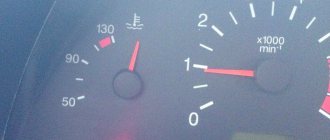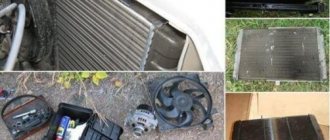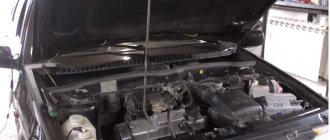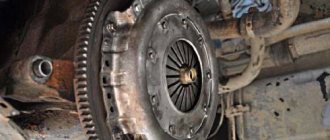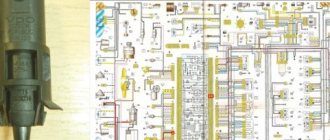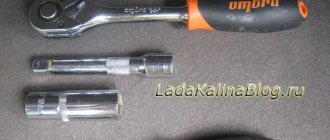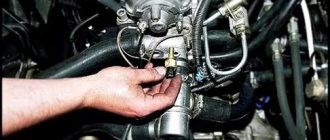The engine cooling system is a solution that allows you to keep the temperature of the power unit within strictly specified limits. This temperature is called the engine operating temperature. The need to maintain the engine in a limited temperature range is due to the fact that overheating can lead to deformation of the cylinder head, breakdown of the unit, its jamming, etc. In parallel with this, active driving on a cold engine is also not expected.
We also recommend reading the article about the design of the cooling system of an internal combustion engine. From this article you will learn about the main structural elements of such a system, as well as the purpose and operating principles of the system and its components.
The fact is that when designing a motor, engineers take into account many important parameters, for example, thermal gaps between mating parts, the efficiency of atomization and combustion of the fuel-air mixture under conditions of a certain heating of the combustion chamber, etc. It turns out that for normal operation of the engine, preserving its service life, fuel efficiency and compliance with toxicity standards, the engine must first reach the design operating temperature, after which this temperature cannot be exceeded or lowered. In this article we will talk about why the engine temperature drops while driving, why the temperature of the power unit drops at idle, or why the engine temperature arrow begins to drop down after the heater is turned on.
Why does the engine temperature drop while driving?
But the problem has not gone away, and everything here has even become warmer, but the problem remains. Further interesting, no matter where I went, everyone said the same thing - thermostat!
At speed, the engine temperature drops. Note that a decrease in the temperature of the internal combustion engine while driving can also occur naturally and not be a consequence of any malfunction.
This usually manifests itself in the cold season, that is, during frosts. On many cars, when driving on the highway, the engine temperature drops, since the engine temperature drops when the Chevrolet Lacetti is driving and the front part of the engine compartment is open to blowing by oncoming air. This mode can be considered the most economical, that is, the minimum amount of fuel burns in the cylinders.
For ease of understanding, the lower the speed and the less fuel burned in the cylinders, the less heat the engine has.
Do not forget that in winter the driver constantly uses the stove in the cabin, which additionally takes away heat. This phenomenon is typical for entry-level and middle-class cars, which are often equipped with low-volume internal combustion engines and do not have additional hood insulation.
What is the operating temperature of the Lacetti 1.6?
It is also worth noting that many diesel engines do not heat up well at idle and can cool down noticeably while driving. It is especially noticeable on small cars and models equipped with medium-sized engines.
The situation is also typical for diesel engines, which not only do not warm up well at idle, but also cool down quickly when driving with insufficient intensity. The car heater has a special radiator, which is included in the general operating circuit of the cooling system. When the driver turns on the interior heating, antifreeze passes through it, giving off some of the heat.
Engine temperature drops when driving
The amount that will be given depends on the set temperature of the heater and its operating mode. The higher these indicators are, the more the interior of the car will heat up. If the engine operates at low speeds, and is also used in winter, there may simply not be enough heat to fully warm up the coolant.
Is it possible to slow down the drop in engine temperature when driving a Chevrolet Lacetti engine in cold weather? In the past, different materials were used to create engine insulation. These are the different felt fabrics available in circulation. But such decisions did not keep the heat for long. Modern thermal insulating car blankets are now used. Their composition prevents ignition, which has a positive effect on the safety of vehicle operation.
Also, numerous engine warm-ups will not be required.
This will save time and fuel. When the weather conditions are too harsh, such techniques will be able to retain heat in a short period of time. It is possible to use special covers for the radiator.
Its lower part, together with the pipe, must be thermally insulated in order to maintain a stable temperature of the running engine.
Actions to prepare the cooling system for winter The winter period of operation is difficult for all vehicle owners. Preparatory work will help you be fully prepared. Discussion closed by moderator Lexona The thermostat is located at the coolant outlet from the head, the coolant temperature is maximum here.
Cooling features of domestic cars
The winter season never passes carefree for car enthusiasts who own early brands of Zhiguli. Engine temperature (VAZ-Six is no exception) is often disappointing due to a sufficient number of flaws in the design of the thermostat and cooling system pipelines. There is a possibility in the cold season that the motor will not be able to reach operating temperature due to the natural airflow of the unit. Therefore, motorists use the function of closing the blinds located near the radiator. If they are not available, other devices may be used.
Many car owners use engine insulation (a blanket or a special fabric that retains heat is placed). There is a method for preserving the heat of the system when moving - dismantling the fan impeller to avoid additional airflow.
Attention - air
Finally, another possible reason for sudden movements of the needle is the presence of air bubbles in the antifreeze (“airing” of the system). Since the air and antifreeze have different temperatures, the needle jerks. An indirect sign of this malfunction is the splashing of coolant from the radiator cap or expansion tank, as well as a decrease in the filling volume.
PS In order not to upset Logan drivers, on the Duster and the second generation Logan-Sandero the temperature indicator on the dashboard was completely removed. As they say: no pointer, no problem.
Many motorists have encountered the fact that the temperature indicator arrow on the instrument panel of a VAZ-2114 went up, beyond the red zone. This malfunction can be due to many factors. But, this problem is related to the electrical part of the car.
VAZ-2114 engine temperature arrow goes off scale: photos and videos
Many motorists have encountered the fact that the temperature indicator arrow on the instrument panel of a VAZ-2114 went up, beyond the red zone. This malfunction can be due to many factors. But, this problem is related to the electrical part of the car.
Why the temperature arrow goes off scale - the main reasons!
The normal operating temperature of the engine on the instrument panel is 90 degrees. The arrow indicates the red zone of engine overheating. Learn more about the situation when the instrument panel does not show the engine temperature.
You can find out why the malfunction occurred in your garage, and you don’t have to go to a car service center. But to fix the problem, you may need outside help from professionals.
So, let's look at the main reasons why the temperature arrow on the VAZ-2114 dashboard goes up:
- Dashboard diagram.
- Temperature sensor.
- Wiring harness.
- ECU.
Solution methods
The arrow is off the charts!
When the reasons are identified, you can proceed directly to eliminating them and consider the issue in more detail. So, to begin with, it is worth noting that the motorist will need some knowledge of the design features of the car, as well as knowledge of the electrical part.
Dashboard diagram
Dashboard board
The next step is to find the motor that powers the arrow. There may be two malfunctions here. Which ones exactly:
- Due to a short circuit, the motor winding burned out.
- The wire that is soldered from the motor to the dashboard board has come unsoldered or has come off.
To eliminate this cause, it is necessary to inspect the place and determine the presence of breaks. For complete reliability, it is necessary to ring the contact wires of the motor that close the winding.
Another stage of diagnostics will be the connector that connects to the board. It is necessary to find the contact that is responsible for the temperature indicator and also ring it using a multimeter. If a connection break is detected, it must be repaired.
Attention! If a motorist does not have experience in repairing such components, it is strongly recommended to contact professional auto electricians so as not to cause even more trouble when doing the repairs yourself. They will do everything quickly and efficiently
temperature sensor
The temperature sensor is checked with a multimeter
If the problem was not hidden in the dashboard, then you need to contact the temperature sensor directly. It is this that serves as an indicator of the engine temperature and transmits data through the computer to the needle. Failure of the product can cause a freezing effect and the needle on the dashboard going off scale.
Wiring harness
Disconnecting the wiring harness from the instrument panel for inspection
If the first two reasons are eliminated, but the problem remains, then you should look for the problem in the wiring harness that goes from the engine to the dashboard. Of course, not all motorists are able to cope with this type of diagnosis, due to ignorance of wire pinout. Therefore, in this case, it is also worth contacting professional auto electricians to find out the causes and repair. Although, the reason here is quite simple and understandable - a wire break or burnout.
ECU
List of ECU errors
It is not often that the problem of the needle leaving its normal position can be caused by an electronic control unit. It is he who sets all the parameters and signals on the dashboard.
To troubleshoot the problem, you need to connect to it and check for errors related to the temperature sensor and cooling system. Thus, a simple reset of errors can lead to normal operation of the device.
There are not many reasons why the VAZ-2114 engine temperature needle goes off scale, but all of them are quite difficult to diagnose, and some can only be eliminated in a car service center. Therefore, if the motorist has not carried out repair operations of this nature, it is necessary to contact a car service center, where they will help and repair everything.
What should the temperature be?
The temperature arrow tends to the red zone - soon overheating
According to the international automobile convention of December 1, 1992, where 92 representatives of the auto industry gathered, it was decided to establish a single standard for engine operating temperature.
This indicator is 90 degrees Celsius with a maximum permissible deviation of no more than 3 degrees Celsius.
With the development of the automotive industry and a sharp leap in technology in the 2000s, in 2004 it was decided to revise this indicator. So, having considered all the facts and analyzed the design features of many cars, it was decided to establish a floating indicator with marginally acceptable standards, which, today, is 85-105 degrees Celsius.
Operating range on the VAZ-2114
If we consider cars produced at the AvtoVAZ plant, including the VAZ-2114, then the operating temperature range for engines is considered to be 87-103 degrees Celsius. If we consider this issue from the point of view of functionality, then this is the optimal indicator.
If the temperature drops below the limit level, then the Samara-2 engine loses dynamics and power, and if it is higher, it can simply boil and cause great damage. Therefore, if malfunctions associated with the cooling system occur, they must be eliminated as soon as possible.
Cooling system design
Before considering cooling system malfunctions, as well as methods for eliminating them, novice motorists should study the cooling system.
So, let's look at what elements it consists of:
Cooling system design
1 – element in the form of a plug for the expansion tank; 2 – expansion tank; 3 – hose for draining liquid from the pipe; 4 – hose passing between the radiator and the expansion tank; 5 – hose leading from the radiator; 6 – tank to the left of the radiator; 7 – aluminum tube; 8 – plug systems; 9 – tank to the right of the radiator; 10 – drain plug; 11 – middle of the radiator; 12 – casing for electric fan; 13 – plastic wings of the electric fan; 14 – electric motor; 15 – toothed pump pulley; 16 – pump impeller; 17 – camshaft drive belt; 18 – engine block; 19 – pump pipe; 20 – radiator hose with supply function; 21 – heater radiator hose with drain function; 22 – hose supplying coolant to the throttle pipe; 23 – exhaust pipe; 24 – hose for refilling; 25 – heater radiator hose with supply function; 26 – thermostat; 27 – coolant temperature sensor; 28 – coolant level indicator sensor.
Main malfunctions and ways to solve them
The operating temperature of the engine is directly affected by the health of the cooling system.
Almost every node can affect changes in this indicator in both directions, so it is necessary to monitor its serviceability and prevent changes. It is temperature fluctuations that can lead to breakdowns of other engine systems. So, let's look at the components of the cooling system, their malfunctions and solutions.
Cooling radiator
Dirty engine radiator
The radiator is considered one of the most reliable parts. There are not many reasons that can lead to product failure, but they can be prevented. A clogged part can lead to an increase in engine operating temperature, but regular cleaning of the internal and external surfaces will bring it back to normal.
The formation of cracks can cause the radiator to leak, but this problem can be dealt with. There are two methods to solve the problem: soldering the surface or replacing the product completely. Thus, repair and restoration work normalizes the operation of the part, as well as the operating temperature in the system.
Pipes
Dirt and rupture of the SOD pipe can lead to a change in the operating temperature of the motor
The cooling system pipes can directly affect the temperature increase in the system. This is due to the fact that if cracks or delaminations form in them, it may happen that the coolant begins to leak out. In turn, the lack of “cooling” will lead to an increase in temperature, which can affect both the operation of the main power unit and increased wear.
Basic faults
If the sensor is working correctly, the needle moves smoothly, but if there is a problem, the movements will be sharp and jerky. With such work, not only can it be impossible to correctly assess the temperature position, but it can also cause damage to the engine and the entire system. Breakdowns can be different and happen in several places at once, but most often motorists encounter the following reasons:
- Thermostat failure.
- Malfunctions in the operation of the coolant temperature sensor.
- Malfunction of the indicator itself and the sensor needle.
- Short circuit in the electrical board.
These causes are arranged according to frequency of occurrence, so we advise you to make the same diagnosis. If it is possible to turn to a specialist for help, this will significantly reduce the time it takes to find and eliminate the cause.
Thermostat failure
The problem with the thermostat is the most common, and all because of the poor protection of this part. The fact is that it can break even on a new car. Some people talk about randomness, and others about the conditions of use. One way or another, it is worth understanding how this system works and how to check its serviceability.
Often such breakdowns occur at low temperatures, but can and will also occur in the opposite conditions (heat waves). When the car starts and the engine warms up, the sensor needle immediately jumps to the correct value, and then the thermostat opens. The coolant begins its movement through all components through the pipes, however, if the thermostat is broken, it shorts out and blocks further passage for the liquid. There are cases of complete closure of the thermostat valve, and there are cases of partial closure, but in both cases, prolonged operation of the engine will lead to overheating and the engine temperature sensor will jump.
To independently diagnose, you should check the thermal state of the supply pipes. In cases where the thermostat is stuck, the lower pipe will be colder than the top. This will prevent the coolant from making a large circle and the engine from starting to operate normally.
Coolant temperature sensor
The next most common breakdown is the coolant temperature sensor. Sometimes it may happen that a contact in it comes loose and data will not flow or will come with breaks in the circuit. Because of this, the needle will twitch, because for it the indicators jump sharply from the working value to zero. There is also a possibility that the sensor itself is broken and it simply cannot record data properly.
When each sensor is detected, you need to make sure that it is intact, as well as that the contacts are properly connected. To fix it, two people will be needed: one moves the contact, and the other monitors the arrow readings. If the arrow reacts to actions and starts jumping, then the problem is with this sensor.
Arrow and temperature sensor
In cases where the thermostat and the thermal sensor connection contact are in order, it is worth paying attention to the sensor indicator itself, there may be malfunctions in the integrity of these parts. In order to identify a breakdown, you need to have certain knowledge about the resistance and structure of this electrical mechanism
Because perhaps it is the poor condition of the sensor that makes the needle jump like crazy.
This knowledge can be studied independently on the Internet or in specialized books, where all operations and indicators are carefully described. But the best outcome, of course, would be to contact a specialist who already knows about all the intricacies of the sensor design.
Electrical board of instrument panel
If everything works well, but the temperature sensor still jumps, then all that remains is to disassemble the instrument panel and check the electrical board. If the soldering is broken or done poorly, it will lead to problems like this. If you plan to fix this problem yourself, we recommend taking a soldering iron with a thin rod and low power so as not to damage the board and adjacent parts.
It is also worth paying special attention to the output mass and resistors. And if you can’t do this kind of work yourself, then contact a specialist who will do it quickly and without errors.
Why the temperature arrow goes off scale - the main reasons!
The normal operating temperature of the engine on the instrument panel is 90 degrees. The arrow indicates the red zone of engine overheating. Learn more about the situation when the instrument panel does not show the engine temperature.
You can find out why the malfunction occurred in your garage, and you don’t have to go to a car service center. But to fix the problem, you may need outside help from professionals.
So, let's look at the main reasons why the temperature arrow on the VAZ-2114 dashboard goes up:
- Dashboard diagram.
- Temperature sensor.
- Wiring harness.
- ECU.
Solution methods
The arrow is off the charts!
When the reasons are identified, you can proceed directly to eliminating them and consider the issue in more detail. So, to begin with, it is worth noting that the motorist will need some knowledge of the design features of the car, as well as knowledge of the electrical part.
Dashboard diagram
Dashboard board
The next step is to find the motor that powers the arrow. There may be two malfunctions here. Which ones exactly:
- Due to a short circuit, the motor winding burned out.
- The wire that is soldered from the motor to the dashboard board has come unsoldered or has come off.
To eliminate this cause, it is necessary to inspect the place and determine the presence of breaks. For complete reliability, it is necessary to ring the contact wires of the motor that close the winding.
Another stage of diagnostics will be the connector that connects to the board. It is necessary to find the contact that is responsible for the temperature indicator and also ring it using a multimeter. If a connection break is detected, it must be repaired.
Attention! If a motorist does not have experience in repairing such components, it is strongly recommended to contact professional auto electricians so as not to cause even more trouble when doing the repairs yourself. They will do everything quickly and efficiently
temperature sensor
The temperature sensor is checked with a multimeter
If the problem was not hidden in the dashboard, then you need to contact the temperature sensor directly. It is this that serves as an indicator of the engine temperature and transmits data through the computer to the needle. Failure of the product can cause a freezing effect and the needle on the dashboard going off scale.
Wiring harness
Disconnecting the wiring harness from the instrument panel for inspection
If the first two reasons are eliminated, but the problem remains, then you should look for the problem in the wiring harness that goes from the engine to the dashboard. Of course, not all motorists are able to cope with this type of diagnosis, due to ignorance of wire pinout. Therefore, in this case, it is also worth contacting professional auto electricians to find out the causes and repair. Although, the reason here is quite simple and understandable - a wire break or burnout.
ECU
List of ECU errors
It is not often that the problem of the needle leaving its normal position can be caused by an electronic control unit. It is he who sets all the parameters and signals on the dashboard.
To troubleshoot the problem, you need to connect to it and check for errors related to the temperature sensor and cooling system. Thus, a simple reset of errors can lead to normal operation of the device.
The engine temperature arrow jumps: why does this happen and what should the driver do?
Many drivers are well aware that constant monitoring of engine temperature allows timely detection of possible problems with the cooling system and protects the engine from overheating and costly repairs.
For this reason, experienced car owners constantly pay attention to the internal combustion engine temperature gauge while driving a car.
In this article we will talk about why the engine temperature arrow rises, then the pointer drops, and also why the power plant temperature sensor may give incorrect readings, the engine temperature arrow floats while driving, etc.
What causes a decrease in temperature
Any equipment is not immune from failure of some components and assemblies. It is necessary to pay attention to the condition of the machine and its systems. An unpleasant situation when the engine temperature drops while driving is due to malfunctions of the cooling system elements. To understand the essence of the problem, it is necessary to have a general understanding of how the power plant is cooled.
It is necessary to monitor the coolant level and the condition of the connecting pipes and the radiator itself. The system has small and large cooling circuits. The difference is that a complete circulation circuit drives the fluid through the radiator. The mechanism that switches the circuits is called a thermostat. Situations where the engine temperature does not rise often occur in winter. Rarely, the working fluid status indicator on the instrument panel is faulty. It is possible to use some materials for insulating the power plant.
Engine temperature arrow goes off scale VAZ 2110 what to do
- Registration
- Entrance
- To the beginning of the forum
- Forum Rules
- Old design
- FAQ
- Search
- Users
When you turn on the ignition, the needle goes off scale well beyond the red zone. Moreover, on a cold engine this does not happen immediately, but after a few seconds. Where to “dig”?
These are different sensors. Judging by what you wrote, you have an injector. And you tore off the two-pin sensor, which is near the thermostat. When there is a malfunction (the connector is pulled out), the ECU turns on the fan. And there is another sensor on the instrument panel, it is in the head of the block at the end of the engine below the thermostat (like a carburetor), one wire goes to it. Watch it.
can be more. I mean, how to find the sensor - there are a ton of them, at first I thought about one - it turned out to be a knock sensor
If you look at the engine, then on the right side there is such a pipe with a rubber cover sticking out, and a wire is put on it. True, this is how it is on my carb, in theory it should be like this on the engineer too.
_________________21093 95 onwards (bucket) —> 2108 87 onwards (Wrx sti)
I had the same problem. The sensor flew into the red zone and very rarely showed the correct value. The technicians took a look and told me to change the panel assembly. I installed the 15th VDO panel - now I’m enjoying myself)
Source
How to remove the coolant temperature sensor from a VAZ 2114?
First, you need to pay attention to the fact that the power unit of the car model in question usually operates at a temperature of 80-90 degrees. This is the ideal temperature, but changes are possible depending on certain factors
If the engine heats up for a long time or quickly, then the problems need to be solved. So, to replace you will need to do the following:
- let the car cool down;
- prepare keys 8, 13, 17;
- prepare a container for draining the coolant;
- remove the power unit protection;
- disconnect the radiator fasteners;
- turn on the stove, and then open the tap and the expansion tank cap;
- Place a container under the radiator and unscrew the cap. Work must be done slowly because the coolant is under pressure;
- place the container under the radiator for 10-15 minutes;
- Place the container under the engine and unscrew the cover from the cylinder block (it is located under the ignition module).
At the next stage, you need to find the temperature sensor, remember its location and remove it using the 21 key. Next, you need to install a new device with the corresponding marking. The sensor should be in the same position as its predecessor.
For a quality connection, it is recommended to apply heat sealant to the threads. After this, all that remains is to add coolant. Then you need to start the car and look at the coolant temperature indicator sensor of the VAZ 2114, making sure that the system is functioning normally.
Unfortunately, after all the operations performed, the device does not always work as expected. It is recommended to ensure that the new sensor is installed correctly. Sometimes motorists forget to add fluid to the system. But there are also situations when the product turns out to be defective. The car may be unstable. Therefore, if replacing the sensor on your own does not bring the desired result, the car owner has only one thing left - contacting a trusted car service center.
Source
Using water as a cooling medium
The use of water to cool the power plant in winter is not recommended, but is allowed. The system must be filled with already heated water to avoid difficult starting of the engine with increased wear of parts. The radiator and motor must be insulated. Heated water must be poured with the drain valves open several times. Then close the taps, fill the system and start starting.
After the end of the trip, the liquid must be drained when it cools down to 45-50 degrees. If you empty the system immediately upon arrival, cracks and other defects may appear. Leaving the water system in frosty conditions is unacceptable. When freezing, the liquid will expand and render the engine, radiator and other components unusable.
The temperature arrow drops: possible reasons
Let's start with the fact that the working fluid (coolant) in the cooling system circulates in a small and large circle. A small circle assumes the movement of antifreeze only along the cooling jacket, that is, without liquid entering the cooling radiator. A large circle means that the liquid enters the radiator, cools there and is again supplied to the cooling jacket. A valve, more familiar to car enthusiasts called a thermostat, is responsible for passing coolant through a large circle.
The thermostat is designed so that it opens only if the antifreeze, antifreeze or water (working fluid) in the cooling system is heated to a certain temperature. Now about various malfunctions. Most often, a problem with the thermostat manifests itself in such a way that the engine overheats. The reason is that the thermostat does not open when the coolant heats up, that is, it does not allow the liquid to circulate in a large circle and cool. In parallel with this, the problem may also occur when the engine warms up for a very long time, the engine heats up normally, but after warming up while driving, the engine temperature drops, etc.
The culprit of troubles in the form of such underheating of the engine is the thermostat. The fact is that this device can jam or “stick”. In other words, if the thermostat does not close completely, then some of the liquid constantly enters the radiator (goes in a large circle), as a result of which the engine is not able to warm up to operating temperature. It happens that the thermostat sticks not from the very beginning, but after the engine warms up. In such cases, the internal combustion engine warms up normally and quickly, after which the thermostat opens and allows liquid to flow into the radiator, but then does not close partially or completely. In such a situation, the engine temperature drops at idle, and the temperature needle may begin to drop while driving. Such temperature jumps can be observed constantly or periodically. Quite often, after stopping a warm engine for several minutes, the thermostat does not close. As a result, after restarting, the power unit cools down very quickly.
The viscous coupling completes the list. If you have a car with a longitudinally mounted engine, the cooling fan of which is on a viscous coupling, then the latter may jam. If the clutch jams, then the engine may be cold all the time or may not reach operating temperature. Let’s add that in order to warm up the internal combustion engine and the interior a little, you can tie the fan blade with electrical tape, which will fix it (the fan does not rotate) after starting the power unit and increase the engine temperature. It should be borne in mind that after warming up the engine, you need to allow the fan to rotate again or monitor the temperature, as the risk of further overheating of the power unit increases.
What actions to take to troubleshoot problems
The simplest way is to replace the faulty device. But on early brands of domestically produced equipment, even new thermostats do not always cope with their function when the engine temperature systematically drops while driving.
The cause of the trouble is the imperfection of its design. There is a way to install more advanced regulators. They are installed on the tenth VAZ model. This thermostat is equipped with six holes, is capable of effectively maintaining the engine temperature in winter, and is collapsible. In the future, you will not need to replace the entire assembly, only the faulty elements. Moreover, in the summer, the operation of thermostats is no different.
